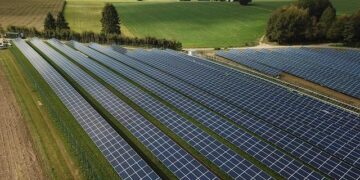The energy required to heat, cool, and power American homes makes up about a fifth of all greenhouse gas emissions the United States produces every year. And, even as the nation transitions to renewable energy and buildings grow more efficient, the housing sector is not changing fast enough to meet the nation’s climate targets. At the same time, a growing number of Americans — some 20 million people as of 2022 — are falling behind on their utility bills.
On Thursday, the Department of Energy took aim at both of those issues, announcing the Biden administration’s goal of cutting the cost of home decarbonization in half and slashing household energy costs at least 20 percent by the end of the decade.
“Every American deserves to live in a home with affordable, clean, reliable power,” said energy secretary Jennifer Granholm in remarks prepared for the announcement. Energy savings, she said, “means real money back into the pockets of hard-working Americans.”
The effort will focus on spurring cheaper ways of retrofitting households that make below 80 percent of their area’s median income. Granholm highlighted low-cost approaches such as installing simple, compact heat pumps and insulated panels for exterior walls.
The new targets are part of the Biden administration’s broader Justice40 initiative, which aims to funnel 40 percent of the benefits of federal climate action to low-income and minority communities. But the hope is that any solutions will be applicable elsewhere as well.

U.S. Secretary of Energy Jennifer Granholm.
Drew Angerer/Getty Images
“We want to look at technologies that can start in affordable housing and go to the larger built environment,” said Ram Narayanamurthy, deputy director of the Energy Department’s building technologies office. ”We know that we have to drive down the costs, and make energy more affordable.”
The push announced today, called the Affordable Home Energy Shot, is the eighth and final pillar in the agency’s “Energy Earthshot” initiative, the objective of which is to accelerate the Biden administration’s attempt to roughly halve the nation’s emissions by 2030. The first of these initiatives, the “Hydrogen Shot” announced in the summer of 2021, set the goal of reducing the price of clean hydrogen fuel by 80 percent by 2030. Other “shots” include driving down the cost of floating offshore wind technology, geothermal energy, and technology to remove carbon dioxide from the atmosphere.
“The Affordable Home Energy Earth Shot is a great example of the federal government stepping in to fill a real gap in the market,” said Sara Baldwin, senior director of electrification at Energy Innovation Policy & Technology, a nonprofit energy and climate think tank. She pointed to the success of the Department of Energy’s 2011 SunShot initiative to cut the cost of utility-scale solar to $1 per watt within a decade. Prices hit that mark in 2017, roughly three years early.
Funding for the latest efforts flows from the bipartisan infrastructure law enacted in 2021 and the Inflation Reduction Act of 2022. The two sweeping laws provided $13.5 billion for the Department of Energy’s housing programs.
On Thursday, the Biden administration also announced $30 million in clean energy funding from the infrastructure bill for 27 states, counties, and cities, as well as the MOWA Band of Choctaw Indians in Alabama. The grants, awarded to help primarily low-income and minority communities, will be disbursed by states and local governments to fund rural electrification projects, build electric vehicle charging stations, and power hospitals, among other local initiatives.
The Department of Energy admits that ensuring Justice40 communities will get their share of the research and development benefits from the latest energy shot will be harder than simply tracking grant dollars. Many of those same communities have already criticized the administration for failing to define exactly what such a “benefit” is and keeping what amounts to a very loose score of where the funds are going.
“Not every project is going to be something that directly serves a community,” said Michael Reiner, a policy analyst in the Energy Department office of economic impact and diversity. ”But you want to know that what you’re investing in is making progress toward something that will.”
The department is also still in the process of establishing the benchmarks and processes for assessing progress on achieving the latest Earthshot’s overall reduction goals. But, officials say, the first step is ensuring that everyone is working toward the same end.
“It’s really about pushing the innovation forward with new materials [and] new technology in a way that can bring down the cost of what’s currently needed to decarbonize homes,” said Jennifer Arrigo, the department’s director for science and energy crosscuts. “Energy Shots are meant to provide that North Star.”
>>> Read full article>>>
Copyright for syndicated content belongs to the linked Source : Grist – https://grist.org/buildings/biden-administration-launches-earthshot-effort-to-slash-energy-bills/































